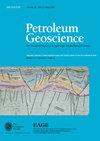Integration of electromagnetic, resistivity-based, and production logging data for validating lithofacies and permeability predictive models with tree ensemble algorithms in heterogeneous carbonate reservoirs
IF 1.9
4区 地球科学
Q3 GEOSCIENCES, MULTIDISCIPLINARY
引用次数: 0
Abstract
This study develops an innovative workflow to identify discrete lithofacies distributions with respect to the well-log records exploiting two tree-based ensemble learning algorithms: extreme gradient boosting (XGBoost) and adaptive boosting (AdaBoost). In the next step, the predicted discrete lithofacies distribution is further assessed with well-log data using an XGBoost regression to predict reservoir permeability. The input well logging records are gamma ray, neutron porosity, bulk density, compressional slowness and deep and shallow resistivity. These data originate in a carbonate reservoir at the Mishrif basin of southern Iraq's oil field. To achieve solid prediction of lithofacies permeability, random subsampling cross-validation was applied to the originated dataset to formulate two subsets, training for model tuning and testing for prediction of subsets that are not observed during model training. The values of total correct percentage (TCP) of lithofacies predictions for the entire dataset and testing subset were 98% and 93% by the XGBoost algorithm; and 97% and 89% using the AdaBoost classifier, respectively. The XGBoost predictive models led to attain the least uncertain lithofacies and permeability records of the cored data. For further validation, the predicted lithofacies and reservoir permeability were then compared with the porosity-permeability values derived from the Nuclear-Magnetic Resonance (NMR) log, the secondary porosity of the Full-bore Micro Imager (FMI) and the production contribution from the Production-Logging Tool (PLT). Therefore, it is believed that the XGBoost model is capable of making accurate predictions of lithofacies and permeability for the same well's non-cored intervals and other non-cored wells in the investigated reservoir.整合电磁、电阻率和生产测井数据,在异质碳酸盐岩储层中利用树状集合算法验证岩性和渗透率预测模型
本研究开发了一种创新的工作流程,利用两种基于树的集合学习算法:极梯度提升(XGBoost)和自适应提升(AdaBoost),根据井记录识别离散岩性分布。下一步,利用 XGBoost 回归法对预测的离散岩性分布与测井数据进行进一步评估,以预测储层渗透率。输入的测井记录包括伽马射线、中子孔隙度、体积密度、压缩慢度以及深层和浅层电阻率。这些数据来自伊拉克南部油田米什里夫盆地的一个碳酸盐岩储层。为实现对岩性渗透率的可靠预测,对原始数据集进行了随机子采样交叉验证,以形成两个子集,即用于模型调整的训练集和用于预测模型训练期间未观察到的子集的测试集。采用 XGBoost 算法,整个数据集和测试子集的岩性预测总正确率(TCP)分别为 98% 和 93%;采用 AdaBoost 分类器,则分别为 97% 和 89%。XGBoost 预测模型使岩心数据中岩性和渗透率记录的不确定性最小。为了进一步验证,将预测的岩性和储层渗透率与核磁共振(NMR)测井、全孔径微成像仪(FMI)的二次孔隙度以及生产测井工具(PLT)的产量贡献进行了比较。因此,我们认为 XGBoost 模型能够准确预测同一油井的非刻蚀层段以及所调查储层中其他非刻蚀油井的岩性和渗透率。
本文章由计算机程序翻译,如有差异,请以英文原文为准。
求助全文
约1分钟内获得全文
求助全文
来源期刊

Petroleum Geoscience
地学-地球科学综合
CiteScore
4.80
自引率
11.80%
发文量
28
审稿时长
>12 weeks
期刊介绍:
Petroleum Geoscience is the international journal of geoenergy and applied earth science, and is co-owned by the Geological Society of London and the European Association of Geoscientists and Engineers (EAGE).
Petroleum Geoscience transcends disciplinary boundaries and publishes a balanced mix of articles covering exploration, exploitation, appraisal, development and enhancement of sub-surface hydrocarbon resources and carbon repositories. The integration of disciplines in an applied context, whether for fluid production, carbon storage or related geoenergy applications, is a particular strength of the journal. Articles on enhancing exploration efficiency, lowering technological and environmental risk, and improving hydrocarbon recovery communicate the latest developments in sub-surface geoscience to a wide readership.
Petroleum Geoscience provides a multidisciplinary forum for those engaged in the science and technology of the rock-related sub-surface disciplines. The journal reaches some 8000 individual subscribers, and a further 1100 institutional subscriptions provide global access to readers including geologists, geophysicists, petroleum and reservoir engineers, petrophysicists and geochemists in both academia and industry. The journal aims to share knowledge of reservoir geoscience and to reflect the international nature of its development.
文献相关原料
| 公司名称 | 产品信息 | 采购帮参考价格 |
|---|
 求助内容:
求助内容: 应助结果提醒方式:
应助结果提醒方式:


